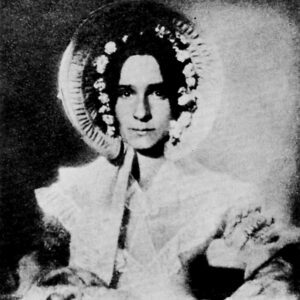Dorothy finished applying a layer of flour to her already pale face, put on her best early Victorian bonnet (complete with a semicircle of flowers atop her hair), and sat in a chair in a studio near New York’s Washington Square. She stayed still as a stone for an agonizing 65 seconds, during which she couldn’t budge or blink; she was barely allowed to breathe. Finally, she was told she could relax. As Dorothy slumped back in her seat, she had no way of knowing she’d just made history.
What the attractive woman in her early 30s had done for the very first time would go on to be repeated countless times over the next two centuries. And she did it out of love for her kid brother.
The Drapers were a happy family living in England as the 19th century began. Dorothy was the eldest of four children. Their father was a Wesleyan minister, which required frequent moves whenever he was assigned to a new parish. All those relocations created a special bond of closeness among the siblings.
By the time the dad passed away in 1829, brother John had moved across the Atlantic and was trying to land a teaching job at a Methodist college in Virginia. Dorothy and their mother joined him there.
Dr. John Draper was an eager participant in the new age of science and discovery unfolding at the time. Though he didn’t get the teaching gig as he’d hoped, it didn’t dampen his intellectual enthusaism. He opened a small laboratory and did research, publishing his findings as he went, before entering medical school at the University of Pennsylvania. Doting sister Dorothy supported him financially by giving music and painting lessons.
He became an instructor at Hampden-Sydney College in Virginia, where Dorothy dutifully served as assistant. It was a role she happily played for the rest of her life. When his memoirs were eventually published, Dorothy’s drawings illustrated the book.
Never married, she treated John’s family like her own. When his wife grew seriously ill, Dorothy homeschooled their children. She must have been a good teacher because one son went on to become a surgeon and chemist, another was a doctor and amateur astronomer, and a third became a noted meteorologist (who later named a daughter after his Aunt Dorothy). All in all, it was a remarkable family.
Which brings us back to the story at hand. Somehow, amid all of young John Draper’s many academic accomplishments, he found time for his fascination with the infant art of photography.
In the late 1830s, a pioneering photographer named Louis Daguerre developed a revolutionary technique for using sunlight to capture images on chemically treated plates. His picture of a street scene is considered the first photo that shows people.
Daguerre eventually sold the rights to his process, called daguerreotype photography, to the French government in exchange for a lifetime pension. On August 19, 1839, France released the daguerreotype’s details as a “free gift to the world.”
John Draper enthusiastically jumped into the new medium. He’s credited with taking the very first picture of the moon in 1840. Serving as a professor at New York University, photography—especially portrait photography—occupied his spare time. Which is where big sister once again (ahem) enters the picture.
When she covered her face with a dusting of flour (to reflect excessive light) and sat down in front of her brother’s bulky, wood-encased daguerreotype camera that day sometime around 1840, Dorothy Draper became the subject of the world’s oldest known photograph of a woman.
It’s believed an earlier, blurrier photo was taken showing a woman, but it was destroyed. But Draper’s likeness captured his sister in stunning sharpness and clarity. It was copied and shared at the time, spreading word of the new invention. Thus, Dorothy became the very first of who knows how many images (billions? trillions?) over the next 180-plus years showing females. Her 65-second debut was a far cry from the dazzling glare of nonstop flashbulbs popping as models strut their stuff down fashion show runways, but you’ve got a start someplace.
The experience certainly didn’t harm her health. Dorothy was 94 when she died in 1901. She was buried beside her brother in Brooklyn’s tony Greenwood Cemetery, where figures from three centuries of New York history now rest.

